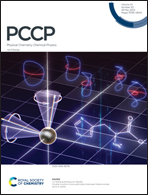Efficient quasi-classical trajectory calculations by means of neural operator architectures†
Abstract
An accurate description of non-equilibrium chemistry relies on rovibrational state-to-state (StS) kinetics data, which can be obtained through the quasi-classical trajectory (QCT) method for high-energy collisions. However, these calculations still represent one of the major computational bottlenecks in predictive simulations of non-equilibrium reacting gases. This work addresses this limitation by proposing SurQCT, a novel machine learning-based surrogate for efficiently and accurately predicting StS chemical reaction rate coefficients. The QCT emulator is constructed using three independent components: two deep operator networks (DeepONets) for inelastic and exchange processes and a feed-forward neural network (FNN) for the dissociation reactions. SurQCT is tested on the O2 + O system, showing a computational speed-up of 85%. Furthermore, we carry out a StS master equation analysis of an isochoric, isothermal heat bath simulation at various temperatures to study how the predicted rate coefficients impact the accuracy of multiple quantities of interest (QoIs) at the kinetics level (e.g., global quasi-steady state (QSS) dissociation rate coefficients and energy relaxation times). For all these QoIs, the master equation analysis relying on SurQCT data shows an accuracy within 15% across the entire temperature regime.

- This article is part of the themed collection: 2023 PCCP HOT Articles


 Please wait while we load your content...
Please wait while we load your content...